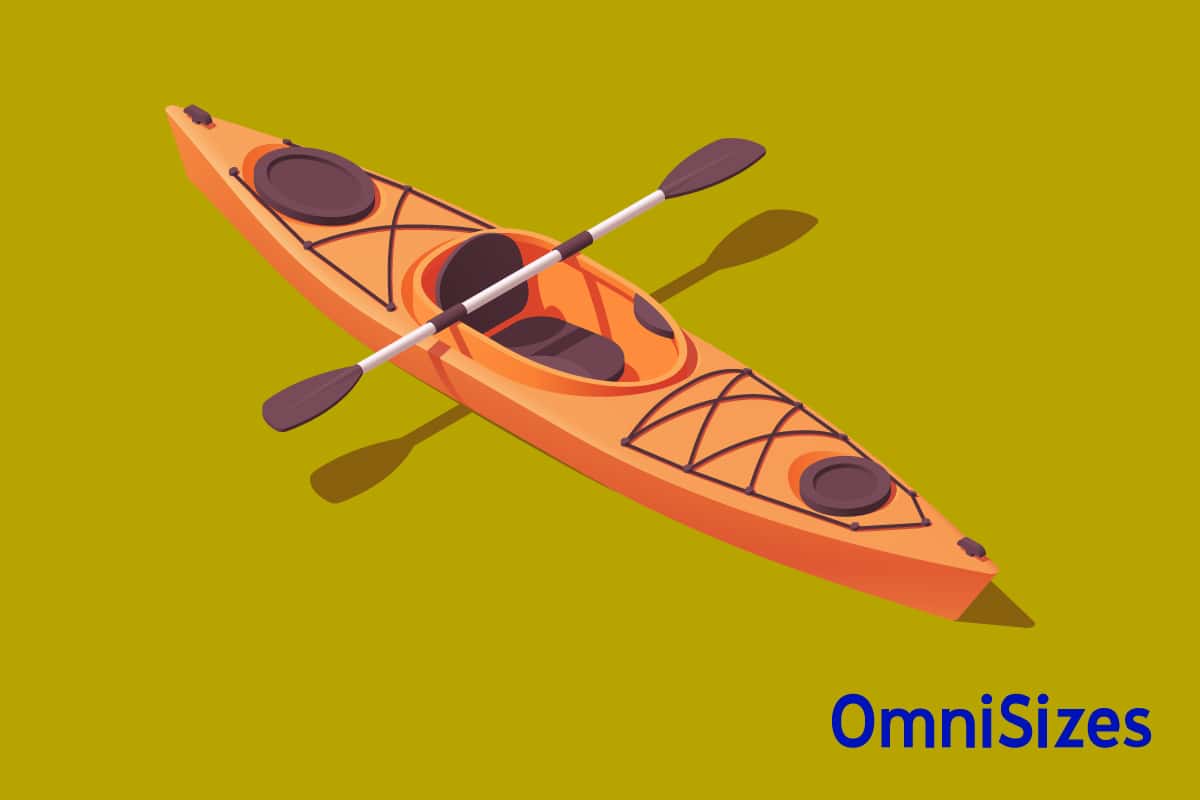Kayaking is an outdoor activity that combines adventure, relaxation, and connecting with nature. Kayak sizes greatly influence the experience, as they determine stability, speed, and suitability for different waters.
The size of a kayak is determined by its type.
- Recreational kayaks typically measure around 8 to 12 feet in length and 27 to 32 inches in width (2.44 to 3.66 × 0.69 to 0.81 m)
- Touring kayaks are longer, often 12 to 17 feet long and 22 to 25 inches wide (3.66 to 5.18 × 0.56 to 0.64 m)
- Whitewater kayaks are shorter, about 6 to 9 feet long, with a width of 24 to 28 inches (1.83 to 2.74 × 0.61 to 0.71 m)
This guide will break down the key concepts of sizing a kayak, as well as common kayak sizes based on various conditions.
Kayak Size Concepts
Kayaking offers a thrilling and enjoyable way to explore waterways, but the key to a great experience lies in selecting the right kayak size. The two most important dimensions to consider when choosing a kayak is length, width, and depth.
The length of a kayak affects its speed and tracking. Longer kayaks glide faster and straighter. Shorter kayaks offer better maneuverability and are suitable for whitewater and tight waterways.
Width, or beam, impacts stability. Wider kayaks provide greater stability, which is excellent for beginners, fishing, or recreational use. However, wider kayaks may be slower. Narrower kayaks are less stable but faster.
The depth of a kayak affects both storage capacity and comfort. Deeper kayaks can accommodate more gear but can be harder to paddle in windy conditions.
Kayak Sizes by Activity Type
Different styles of kayaking require different kayak dimensions for optimal performance.
1. Recreational Kayaks
Recreational kayaks are perfect for casual paddling in calm waters like lakes and slow-moving rivers. They typically range from 8 to 12 feet in length, offering a good balance between easy handling and enough speed for a relaxing day on the water. These kayaks are wider, usually around 30 inches. The spacious cockpits make entry and exit easier and allow more room for comfort.
2. Touring Kayaks
For longer trips or paddling in open waters, touring kayaks (a.k.a. sea kayaks) are the go-to choice. These kayaks are longer, usually between 12 to 17 feet, which caids in straight-line tracking and efficiency over long distances. Their narrower width, around 22 to 25 inches, enhances speed and reduces the effort needed to paddle. Touring kayaks often come with added storage space for gear.
3. Fishing Kayaks
Fishing kayaks are designed for stability and space to accommodate fishing gear. These kayaks are generally wider, about 34 to 38 inches, to ensure stability when casting and reeling in fish. The length varies from 10 to 14 feet, which helps maintain a balance between storage space and maneuverability. Many fishing kayaks also come with specialized features like rod holders, gear tracks, and storage compartments.
4. Whitewater Kayaks
Whitewater kayaking demands agile and robust kayaks. These are typically shorter, about 6 to 9 feet in length, to navigate tight turns and rapid currents. The width, around 24 to 28 inches, balances between stability and the ability to roll the kayak back upright after capsizing. Whitewater kayaks have a low profile and are designed to perform in varying river conditions.
5. Tandem Kayaks
Tandem kayaks are designed for two paddlers and are great for couples, friends, or families. They are generally around 10 to 14 feet to accommodate two people and provide stability and comfort. The width, about 30 to 36 inches, ensures enough space for both paddlers without compromising on the kayak’s handling.
Kayak Sizes by User Needs
In addition to the type of activity you will be doing, you also need to factor in your personal needs, body size, and comfort when choosing a kayak size.
1. Kayaks for Different Body Sizes
Choosing a kayak that fits your body size is crucial for comfort and safety. For taller individuals or those with a larger build, longer kayaks, around 12 to 14 feet, offer more legroom and a better fit. These kayaks are often wider, around 28 to 30 inches.
For smaller paddlers, shorter kayaks, about 8 to 10 feet in length and 24 to 26 inches in width, are easier to handle and more proportional to their body size.
The kayak’s cockpit size also matters–larger cockpits are more comfortable for bigger paddlers, while smaller ones offer better control for smaller individuals.
2. Youth Kayaks
Youth kayaks are specifically designed for children and young paddlers. They are smaller, generally about 6 to 8 feet in length, making them lightweight and manageable for younger users. These kayaks are narrower, around 20 to 24 inches, fitting a child’s smaller frame and providing easier control. Safety features include tow lines and grab handles.
3. Kayaks for Seniors
For older paddlers or those with limited mobility, stability and ease of entry and exit are crucial. Kayaks for seniors are often wider, around 30 to 34 inches, providing stability and reducing the risk of capsizing. The length varies, but shorter kayaks, about 10 to 12 feet, are easier to maneuver and transport.
4. Kayaks for Disabled Paddlers
Kayaks for disabled paddlers often feature adaptive equipment and design modifications. Stability is a primary concern, so these kayaks are usually wider, around 30 to 36 inches. They may include special seating arrangements, outriggers for added stability, and hand-paddling mechanisms. The length can vary, but accessibility and ease of use are key in the design.
Additional Size Considerations
There are additional kayak size considerations beyond just type and primary use.
1. Custom and Specialty Kayaks
Custom kayaks can be tailored in size, shape, and features to suit individual requirements, whether it’s for comfort, specific physical needs, or performance objectives. These kayaks might be longer for better storage and stability in rough waters or shorter and lighter for movement.
2. Transport and Storage
Longer and wider kayaks, while offering more space and stability on the water, can be challenging to transport and store. They may require a larger vehicle, roof racks, or a trailer for transportation. Foldable or inflatable kayaks can be a solution for those with limited storage space.
3. Weight Capacity
This is the maximum weight a kayak can handle while still performing well. It includes the weight of the paddler and any gear or equipment on board. Different kayaks have different weight capacities, generally ranging from 250 to 500 pounds.






